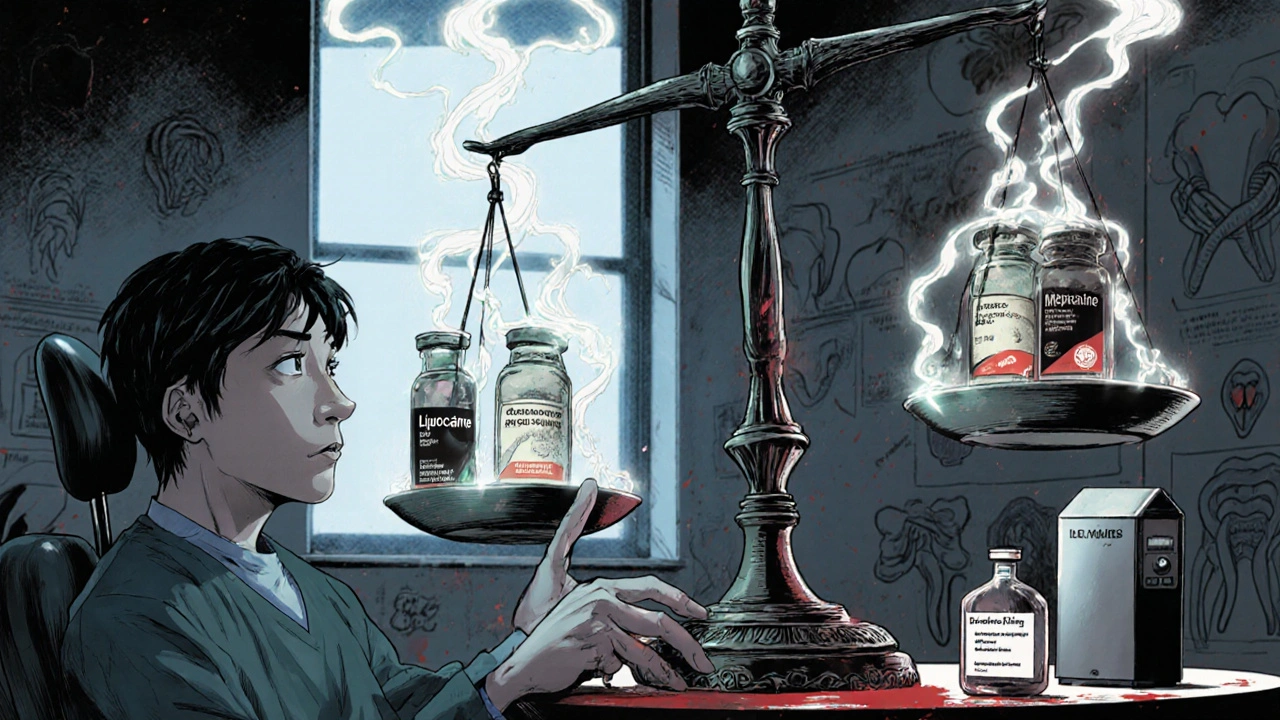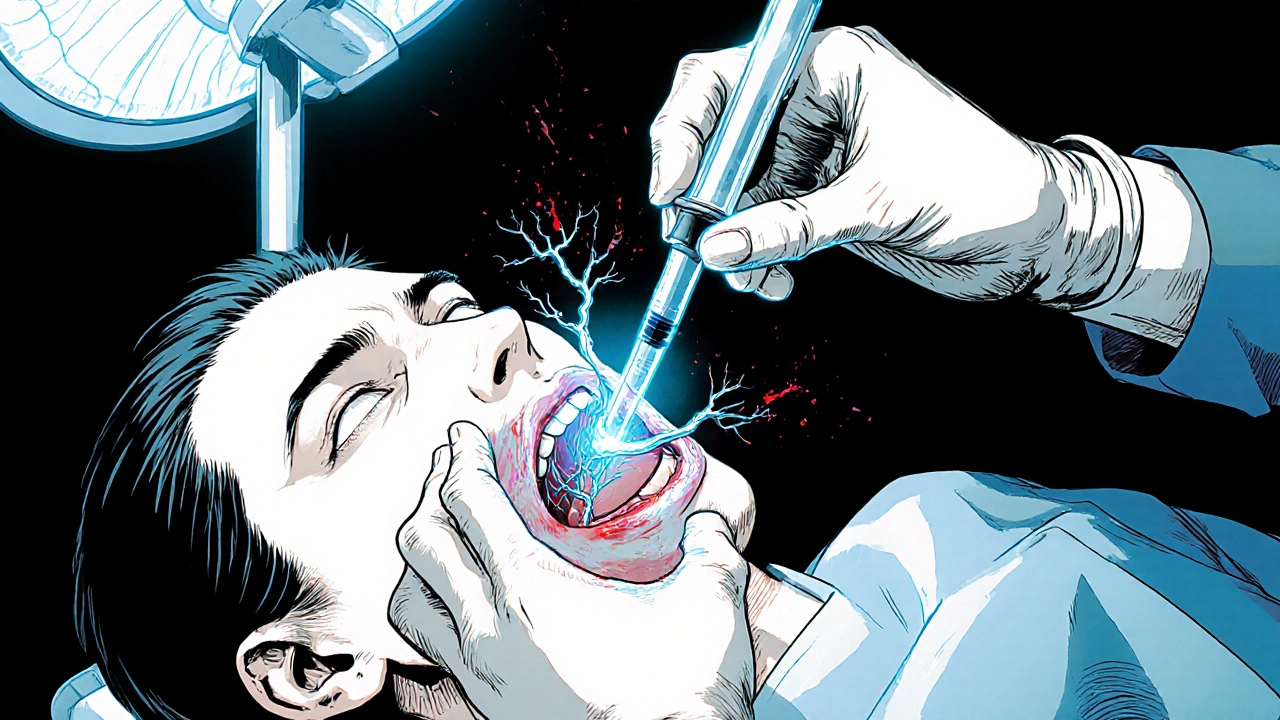Dental Anesthetic Dose Calculator
This calculator helps determine the maximum safe dose of dental local anesthetic based on patient weight and the specific agent used. The calculator follows recommended guidelines for safe dosing to prevent complications.
Dose Results
Local anesthesia is a technique that temporarily blocks nerve signals in the mouth, letting dentists work without causing pain. In cosmetic dentistry-procedures like veneers, crowns, and gum reshaping-this method is the go‑to for most clinicians. But is it always the right choice? Below we break down the real advantages, the hidden drawbacks, and how you can decide what works best for your smile makeover.
What Exactly Is Local Anesthesia in Cosmetic Dentistry?
When you sit in the dental chair for a veneer prep or a porcelain crown, the dentist will inject a small amount of medication near the target nerves. The goal is to numb the specific tooth or group of teeth while you stay fully awake. Unlike general anesthesia, which puts you to sleep, local anesthesia lets you talk, breathe normally, and keep control of your head.
How It Works: The Science Behind the Numb
The oral cavity is packed with branches of the trigeminal nerve. A local anesthetic blocks the sodium channels on nerve fibers, preventing the transmission of pain signals to the brain. Most clinicians use a nerve block technique-either a superior alveolar block for upper teeth or an inferior alveolar block for lower teeth. The anesthetic diffuses into the tissue, creating a zone of insensitivity that lasts anywhere from 30 minutes to several hours, depending on the drug’s properties.
Common Anesthetic Agents Used in Cosmetic Dentistry
Three agents dominate the market:
- Lidocaine - the workhorse, fast onset (2‑3 minutes), moderate duration (2‑3 hours).
- Articaine - slightly stronger, quicker onset, longer lasting (up to 4 hours), useful for deeper preparations.
- Mepivacaine - no vasoconstrictor needed, good for patients with cardiovascular concerns.
Each drug can be mixed with a vasoconstrictor like epinephrine to reduce bleeding and prolong numbness. The choice depends on the procedure’s depth, the patient’s medical history, and the dentist’s personal preference.
| Agent | Onset | Duration | Potency | Max Dose (mg) |
|---|---|---|---|---|
| Lidocaine | 2‑3 min | 2‑3 h | Standard | 4.5 mg/kg |
| Articaine | 1‑2 min | 3‑4 h | Higher | 7 mg/kg |
| Mepivacaine | 3‑4 min | 2‑3 h | Standard | 4.5 mg/kg |

Pros: Why Many Patients and Dentists Opt for Local Anesthesia
- Immediate pain control. As soon as the anesthetic takes effect, you feel no drilling, cutting, or polishing sensations.
- Preserves airway safety. Since you stay conscious, there’s no risk of airway obstruction-a concern with general anesthesia.
- Quick recovery. Most numbness fades within a few hours, letting you eat soft foods and resume normal activities the same day.
- Cost‑effective. Local anesthetic kits cost a fraction of what an operating room or sedation suite would charge.
- Flexibility for multi‑step procedures. A dentist can re‑inject a small amount mid‑procedure without significant downtime.
For example, a patient receiving a full‑arch veneer makeover can have each quadrant numbed separately, keeping the overall appointment under four hours while staying fully alert.
Cons: Potential Drawbacks and Risks to Watch Out For
- Short‑term numbness. The lip, tongue, or cheek may feel “pins and needles” for several hours, which can be uncomfortable or lead to accidental biting.
- Allergic reactions, although rare, can trigger hives, swelling, or, in extreme cases, anaphylaxis.
- Inadequate numbness. Some patients have anatomical variations that make nerve blocks less effective, leading to intra‑operative pain.
- Systemic toxicity. Over‑dose, especially in children or low‑body‑weight patients, can affect the heart or central nervous system.
- Blood pressure spikes. Epinephrine, the common vasoconstrictor, may raise blood pressure-problematic for patients with uncontrolled hypertension.
Dental professionals mitigate these risks with thorough medical histories, dosage calculations based on weight, and real‑time monitoring of patient comfort.
Managing Side Effects: Tips for a Smoother Experience
If you’re scheduled for a cosmetic procedure, here’s how to minimize the downsides:
- Communicate any allergies. Let your dentist know about past reactions to local anesthetics, latex, or other drugs.
- Stay hydrated but avoid alcohol before the appointment; dehydration can heighten the perception of numbness.
- Ask for a “soft diet” plan-smooth soups, yogurt, and scrambled eggs work well while your mouth is numb.
- Use a cold compress on the cheek after the injection to reduce swelling.
- If you feel tingling that won’t subside after 4‑6 hours, contact your dentist-persistent paresthesia, though uncommon, may need evaluation.

Decision Guide: When to Choose Local Anesthesia vs. Alternatives
Not every cosmetic procedure requires a full nerve block. Consider the following matrix when discussing options with your provider:
| Procedure | Typical Anesthesia | When to Upgrade |
|---|---|---|
| Porcelain veneers (minimal prep) | Topical gel or small infiltration | Patient reports high anxiety or low pain threshold. |
| All‑ceramic crowns (deep prep) | Infiltration + peripheral block | Longer operative time (>90 min) or multiple teeth. |
| Gum contouring (laser) | Topical + minimal infiltration | Extensive soft‑tissue removal. |
| Full‑arch makeover (multiple crowns, veneers) | Multiple nerve blocks + conscious sedation | Patient anxiety, gag reflex, or complex occlusion. |
In cases where anxiety is a major factor, dentists may combine local anesthesia with nitrous oxide or oral sedatives. This hybrid approach gives pain control while calming the mind.
Frequently Asked Questions
How long does the numbness last after a veneer prep?
With lidocaine, most patients feel full numbness for 2‑3 hours. The feeling gradually fades, and normal sensation returns by the evening.
Can I be allergic to local anesthetic?
True allergies are rare, but some people react to the preservatives (like methylparaben) or to epinephrine. Your dentist can use preservative‑free formulations if needed.
Is it safe to have multiple teeth numbed in one appointment?
Yes, as long as the total dose stays within the recommended mg/kg limits. Dentists calculate the exact amount based on your weight and the anesthetic used.
What should I eat after the procedure?
Choose soft, room‑temperature foods. Avoid hot soups or crunchy snacks until the numbness fully wears off to prevent accidental burns or bites.
Can local anesthesia affect my heart rate?
When epinephrine is used, a slight increase in heart rate can occur. Patients with uncontrolled hypertension or heart arrhythmias should discuss alternative agents with their dentist.
Bottom Line
Local anesthesia remains the backbone of cosmetic dentistry because it offers fast, targeted pain relief without the overhead of full sedation. Yet, it isn’t a perfect fit for every patient or every procedure. By weighing the pros-quick pain control, low cost, rapid recovery-against the cons-temporary numbness, rare allergic reactions, and dose limits-you can make an informed choice. Talk openly with your dentist about medical history, anxiety levels, and the specific aesthetic goals you have. Together you’ll craft a plan that keeps your smile beautiful and your experience comfortable.
local anesthesia is a reliable, cost‑effective tool for most cosmetic dental work, provided you’re aware of the potential side effects and know how to manage them.






14 Comments
keerthi yeligay
October 23, 2025 AT 13:29 PMBefore getting numbed, tell your dentist about any past allegies to anesthetic or latex; a quick note can prevent a nasty reaction. Keeping the medical history fresh helps the clinician pick the safest agent.
Peter Richmond
October 24, 2025 AT 03:23 AMLocal anesthesia remains cost‑effective compared to sedation suites, reducing both chair‑time expenses and post‑procedure recovery costs.
Bonnie Lin
October 24, 2025 AT 17:16 PMEpinephrine may raise blood pressure so patients with hypertension should discuss alternatives
sara fanisha
October 25, 2025 AT 07:09 AMStick to soft foods like yogurt, mashed potatoes, or scrambled eggs while the numbness wears off – it’ll keep you from biting your cheek accidentally.
Tristram Torres
October 25, 2025 AT 21:03 PMNumbness can feel weird for a few hours.
CASEY PERRY
October 26, 2025 AT 09:56 AMWhen calculating the maximum lidocaine dose, clinicians use the formula 4.5 mg · kg⁻¹; for a 70 kg patient that equals 315 mg, which translates to roughly 2.1 mL of 1:100,000 solution.
Naomi Shimberg
October 26, 2025 AT 23:49 PMWhile the aforementioned dosage calculations appear prudent, one might argue that routine adherence to such stringent limits may unnecessarily restrict therapeutic efficacy, especially in patients with robust cardiovascular reserves.
kenny lastimosa
October 27, 2025 AT 13:43 PMUltimately, the decision to honor or challenge dosage conventions rests with the patient’s informed consent, reflecting a balance between clinical caution and personal autonomy.
Heather ehlschide
October 28, 2025 AT 03:36 AMManaging the after‑effects of local anesthesia starts with proper patient education before the injection. Explain that the numbness will gradually fade and that they should avoid hot liquids until sensation returns. Advise them to chew on the opposite side of the mouth to prevent accidental biting of the lip or cheek. A small ice pack applied to the cheek can reduce swelling and provide a soothing sensation. Encourage hydration, but remind them to skip alcoholic drinks for the remainder of the day, as alcohol can amplify the tingling feeling. Suggest a soft‑diet menu: lukewarm soups, oatmeal, smoothies, and scrambled eggs are ideal choices. If the patient experiences prolonged tingling beyond six hours, they should contact the office to rule out nerve irritation. For those with a known allergy to vasoconstrictors, using plain lidocaine without epinephrine eliminates the risk of blood‑pressure spikes. Dosage calculations should always factor in the patient’s weight, and the total amount should never exceed the recommended mg/kg limit. In pediatric cases, the margin of safety is even tighter, requiring careful measurement of each cartridge. Some clinicians employ a buffering technique with sodium bicarbonate to reduce injection pain and speed onset. Post‑procedure, a gentle mouth rinse with warm salt water can keep the area clean and comfort the soft tissues. Documentation of any adverse sensations helps the dentist refine future anesthetic plans. For patients with anxiety, combining a small dose of nitrous oxide with the local anesthetic offers both pain control and calmness. Always verify that the patient’s medical history is up to date, including any recent heart medications that could interact with epinephrine. By following these steps, the practitioner minimizes complications and the patient enjoys a smoother recovery.
Kajal Gupta
October 28, 2025 AT 17:29 PMHey Kenny, that’s a great point – it’s like giving the patient the steering wheel while the dentist fine‑tunes the engine of comfort.
Zachary Blackwell
October 29, 2025 AT 07:23 AMJust so you know, the dental industry pushes these “comfort” protocols to sell more pricey anesthesia kits, keeping patients hooked on unnecessary meds.
prithi mallick
October 29, 2025 AT 21:16 PMEven if there are profit motives, the core idea of easing pain still holds true – a gentle hand can make a huge diffrence for someone fearful of the chair.
Michaela Dixon
October 30, 2025 AT 11:09 AMI totally vibe with what you’re saying and think that while the market forces are there they’re not the only driver because dentists also genuinely care about patient wellbeing and they often go out of their way to customise the anesthetic mix for each unique smile plan the way an artist selects pigments for a masterpiece its rhythm and tempo matching the procedure’s tempo meaning the whole experience becomes a harmonious collaboration rather than a one‑size‑fits‑all formula and that’s something worth celebrating
Dan Danuts
October 31, 2025 AT 01:03 AMLove that perspective, Michaela! Let’s keep spreading the word that a thoughtful anesthetic plan is a win‑win for comfort and confidence.